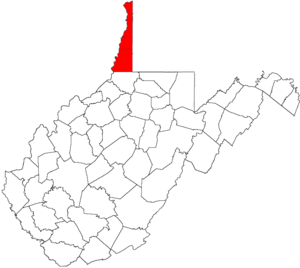Northern Panhandle of West Virginia

The Northern Panhandle is the northern of the two panhandles in the U.S. state of West Virginia. It is a culturally and geographically distinct region of the state. It is the state's northernmost extension, bounded by Ohio and the Ohio River on the north and west and the state of Pennsylvania on the east. Its unusual configuration is the result of the Revolutionary-era claims of Virginia's former Yohogania County boundary lying along the Ohio River, conflicting with interpretations of the Colony of Pennsylvania's royal charter. The conflict was settled by compromise in the 1780s. Today, due to the southern boundary being an extension of the Mason–Dixon line and the panhandle's proximity to the Pittsburgh area, the Northern Panhandle resembles more of the Midwestern United States[1] or the Northeastern United States compared to the rest of the state (including the Eastern Panhandle of West Virginia), which is classified as part of the Upland South.[2]
In 2013 its northernmost two counties were included in the Pittsburgh consolidated area by the U.S. Census.[3]
The following counties, listed from north to south, are universally accepted as being part of the Northern Panhandle:
Banks in these counties are serviced by the Cleveland Federal Reserve district, while the rest of West Virginia is in the Richmond district.
Most West Virginians also include Wetzel County, directly to the south of Marshall County, as a part of the Northern Panhandle, although it does not lie strictly within the northern extension.[4]
Important towns within the Northern Panhandle include Wheeling (once the state capital), Weirton, and Moundsville. The region houses three four-year colleges—the public West Liberty University and the private Bethany College and Wheeling Jesuit University. All five counties listed in this article, plus Tyler County, are in the service area of West Virginia Northern Community College.
In the late 19th century, the Northern Panhandle developed as an industrial area, especially in the manufacturing of steel and glass products. It still largely retains its industrial character, although many of its factories have closed down or fallen on hard times like others in the Rust Belt. The region also contains the Panhandle Coalfield.
See also
References
- ↑ Regional report
- ↑ Regional report
- ↑ http://www.whitehouse.gov/sites/default/files/omb/bulletins/2013/b13-01.pdf
- ↑ "Regional Map". West Virginia Department of Commerce. Retrieved August 11, 2013.
